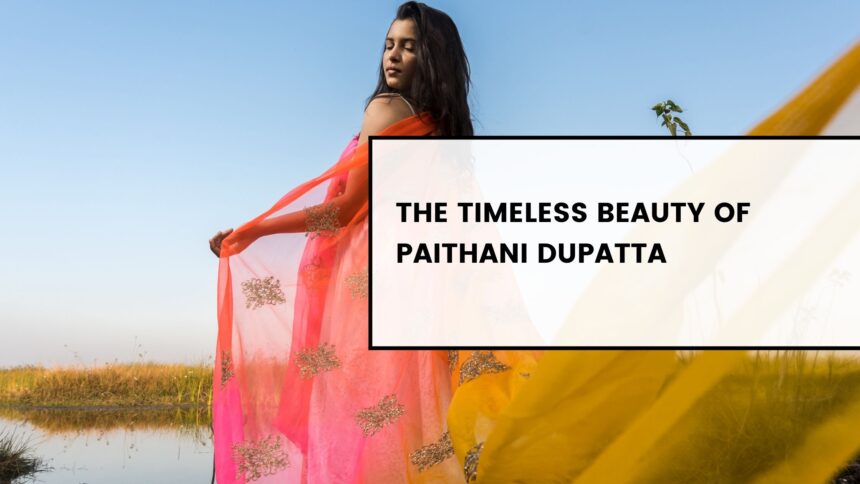Paithani dupattas are among the most revered and exquisite traditional garments in India, known for their intricate craftsmanship, luxurious silk fabric, and vibrant patterns. Originating from Maharashtra, Paithani weaving has been a cultural emblem for centuries, representing the rich heritage of handloom textiles. In this guide, we’ll explore everything you need to know about Paithani dupattas, from their history and craftsmanship to how you can style them for various occasions.
What is a Paithani Dupatta?
A Paithani dupatta is a handwoven piece of fabric made primarily from silk, often adorned with rich zari (gold or silver thread) work. What sets Paithani apart from other traditional textiles is its signature design: a tapestry of intricate floral motifs, peacocks, and vibrant color palettes. The use of the “butti” (small motifs spread across the dupatta) and the traditional “pallu” design with an elaborate border make it a work of art.
Key Features of Paithani Dupattas:
- Silk Base: Pure mulberry silk is typically used in crafting these dupattas.
- Zari Work: Real silver and gold threads are often used for the borders.
- Motifs: Peacocks, lotuses, and other traditional motifs define the look.
- Vibrant Colors: Paithani dupattas are known for their bright, contrasting color combinations.
A Brief History of Paithani
The art of Paithani weaving dates back over 2000 years, originating in the small town of Paithan in Maharashtra, which is how the fabric got its name. Once reserved for royalty and the elite, Paithani textiles have now become a cherished part of India’s rich cultural legacy. The technique involves a painstakingly slow process of hand-weaving, which can take anywhere from weeks to months depending on the complexity of the design.
During the Peshwa dynasty, Paithani gained immense popularity, with wealthy patrons commissioning intricate designs to showcase their status. Even today, the painstaking effort that goes into each piece makes a Paithani dupatta a symbol of luxury and elegance.
Craftsmanship Behind Paithani Dupattas
Creating a Paithani dupatta is a labor-intensive process. Skilled artisans use traditional handlooms, and the method has remained virtually unchanged for centuries.
The Process:
- Silk Spinning and Dyeing: High-quality silk threads are first dyed in vibrant colors.
- Setting the Loom: The artisan sets up the loom, threading each silk strand carefully.
- Weaving: The weaver meticulously works on the dupatta, weaving patterns using zari and silk threads.
- Finishing: After weeks of weaving, the finished dupatta is cut and inspected for any imperfections.
Secondary Keywords:
- Handwoven Paithani dupatta
- Traditional Maharashtrian dupattas
- Zari dupattas for weddings
- Silk dupattas for festive wear
Why Paithani Dupattas Are So Popular
Paithani dupattas have transcended generations, maintaining their allure due to their elegance, timeless design, and the craftsmanship involved. These dupattas are versatile and can be styled in multiple ways for various occasions, making them a staple in Indian wardrobes.
Reasons for Popularity:
- Symbol of Heritage: Owning a Paithani dupatta is like holding a piece of Indian history.
- Versatility: Paithani dupattas can be paired with sarees, lehengas, or even contemporary outfits like anarkalis or salwar kameez.
- Durability: The quality of silk and zari ensures that Paithani dupattas last for decades if maintained properly.
How to Style a Paithani Dupatta
Paithani dupattas can elevate even the simplest outfits. Here are some style tips to help you incorporate them into your wardrobe:
Traditional Look:
Pair a Paithani dupatta with a simple silk saree to allow the dupatta to stand out. Drape it over your shoulder and let the intricate pallu design be the centerpiece of your outfit.
Contemporary Look:
For a modern twist, you can pair a Paithani dupatta with a plain anarkali or salwar kameez. You can drape it around your neck like a scarf or let it flow elegantly from one shoulder for an Indo-western look.
Wedding Ensemble:
Brides can use a Paithani dupatta as part of their wedding attire. It complements traditional bridal lehengas and adds a touch of regal charm to the ensemble.
FAQs About Paithani Dupattas
How do I maintain a Paithani dupatta?
A: To maintain the richness of a Paithani dupatta, store it in a cotton or muslin cloth. Avoid hanging it for long periods, and keep it away from moisture. Dry cleaning is the best way to ensure it stays in pristine condition.
Are all Paithani dupattas handwoven?
A: Genuine Paithani dupattas are handwoven, though machine-made replicas are available at lower prices. Always verify the authenticity when purchasing.
Can I wear a Paithani dupatta with western outfits?
A: Yes, Paithani dupattas can add an ethnic flair to western outfits. Pair it with a plain dress or even a pair of jeans and a solid top for a fusion look.
How much does a Paithani dupatta cost?
A: Prices vary depending on the intricacy of the design and the materials used. Genuine Paithani dupattas can range anywhere from ₹10,000 to ₹100,000 or more.
Table: Comparison of Traditional and Contemporary Paithani Dupattas
| Feature | Traditional Paithani | Contemporary Paithani |
|---|---|---|
| Fabric | Pure silk and real zari | Blended silk and metallic threads |
| Design | Floral motifs, peacocks, lotuses | Minimalist, abstract designs |
| Occasions | Weddings, festivals | Everyday wear, casual outings |
| Price Range | High | Moderate to high |
| Popularity | Timeless classic | Trendy yet rooted in tradition |
Conclusion: Why Every Wardrobe Needs a Paithani Dupatta
In conclusion, a Paithani dupatta is more than just a piece of fabric—it’s a symbol of heritage, craftsmanship, and elegance. Whether you’re attending a wedding or looking for something to elevate your everyday look, Paithani dupattas offer versatility, grace, and a touch of timeless beauty. Explore the range of designs and make sure you own a piece of this rich Indian tradition.
